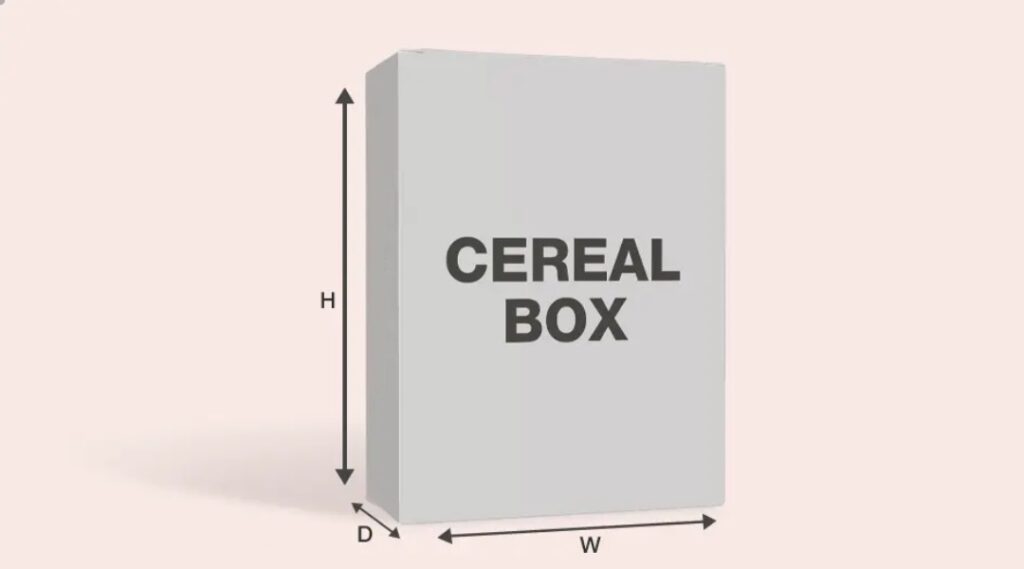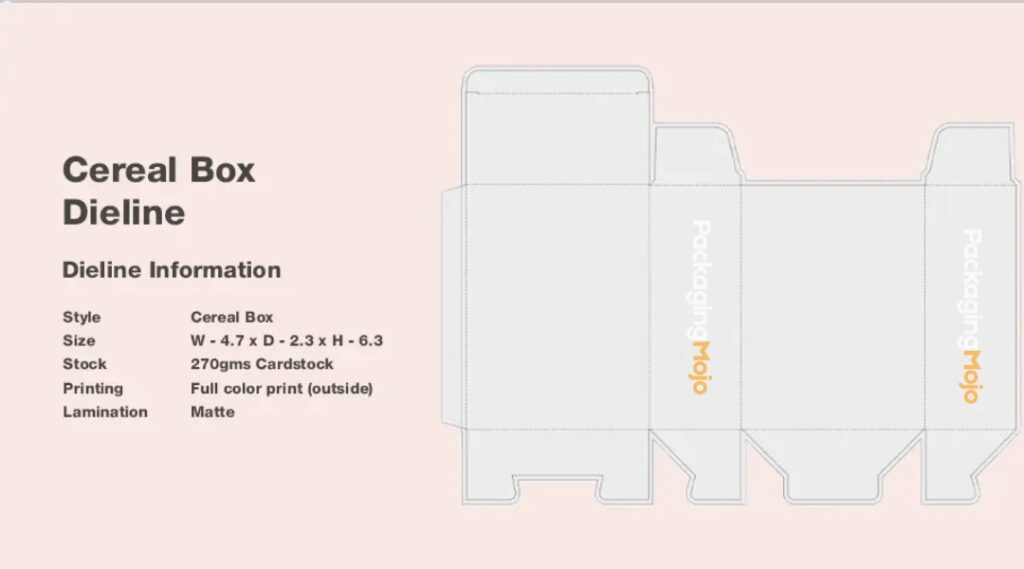Cereal boxes come in different sizes and materials. Some are big, and some are small. The material used also changes. People buy cereal every day, so knowing the right box size helps. The material of the box also matters for storage and recycling.
This guide will assist you in knowing various cereal box sizes and materials. You will know what is suitable for you. Let’s proceed to the details.
Standard Cereal Box Sizes
Cereal boxes are available in small, medium, and big sizes. Small boxes typically hold around 250g of cereal. Medium boxes have around 500g. Large boxes hold 750g or more. Some brands offer family-sized packs with more than 1kg of cereal. The size you pick relies on your requirement. A small box is sufficient for one individual. A large box is better for a big family. Always check the weight before buying.

Cereal Box Size Classifications
Cereal packaging is categorized into three primary size segments: small, medium, and large. Each category aligns with specific consumer needs and storage capacities.
- Small Boxes (≤250g): These compact units are designed for single consumers, product sampling, or travel convenience. They minimize food wastage and facilitate portability.
- Medium Boxes (375g–500g): This is the industry standard, catering to average household consumption. It offers an optimal balance between quantity and storage efficiency.
- Large Boxes (≥750g): Designed for high-frequency consumers and larger households, these bulk packages enhance cost-effectiveness and reduce purchasing frequency.
Mini Cereal Boxes and Their Uses
Mini cereal boxes are very small. They usually contain 30g to 50g of cereal. These boxes are great for travel. Many people buy them for kids’ lunchboxes. Some hotels also serve mini cereal boxes. These boxes help in portion control. They are easy to carry and store. If you do not eat much cereal, mini boxes are a good choice. They also come in variety packs. This lets you try different cereals without buying a big box.
Family-Size Cereal Boxes
Family-size boxes are the biggest ones. They hold 1kg or more of cereal. These boxes are best for large families. They last longer and reduce trips to the store. Buying a big box can save money. The price per gram is usually lower than smaller boxes. However, big boxes take up more space. If your kitchen is small, they might be difficult to store. Check the expiry date before purchasing a big box.
Material Used in Cereal Boxes
Most cereal boxes are made of cardboard. Cardboard is lightweight and easy to recycle. Some custom boxes have plastic windows. These let you see the cereal inside. The inside of the box has a plastic bag. This bag keeps the cereal fresh. Paper bags are used in place of plastic by some companies. Paper bags are more environmentally friendly. Always read the packaging before discarding it. Some materials need special recycling bins.
1. Cardboard
Due in great part to its structural rigidity, printability, and recyclability, cardboard is a commonly used material. It offers mechanical protection but uses an interior liner to stop moisture from seeping in.
2. Polyethylene Liners
Acting as moisture barriers, polyethylene liners preserve cereal texture and increase shelf life by themselves. Their thickness varies and they might be either resealable or single-use.
3. Polymer-Based Pouches
Flexible packaging solutions combining multi-layered films to provide an airtight closure are polymer-based pouches. They maximize product freshness and space economy but create recycling problems.

Eco-Friendly Cereal Packaging
There are many brands today that employ environmentally friendly packaging. There are boxes made of recycled cardboard. Others use biodegradable plastic. Some brands even sell cereal in refillable containers. This helps reduce waste.
Buying cereal in bulk also eliminates packaging. You can also use green alternatives if you care for the environment. Always check the recycling symbols on the box. This will inform you on how to dispose of it accordingly.
- Recycled Cardboard: Use of post-consumer recycled fiber to reduce raw material usage.
- Compostable Liners: Synthesis of biodegradable films that degrade in controlled environmental conditions.
- Mono-Material Pouches: Single-material polymer pouches engineered for higher recyclability.
Why Box Size Matters for Storage
The size of the cereal box affects storage. Small boxes fit easily in cupboards. Large boxes take up more space. If you have a small kitchen, stackable boxes are a good option. Some people transfer cereal into airtight containers. This maintains it fresh as well as saves space. Always make sure that you check the height of your shelves before buying a large box. A non-fitting box can be difficult to store.
How Cereal Box Size Affects Freshness
The bigger the box, the longer it lasts. But once opened, cereal can go stale. If you eat cereal slowly, buy a smaller box. A big box might lose its crunch before you finish it. Always tie up the plastic bag tightly when finished. There are some boxes with resealable bags. These keep the cereal fresh. If your cereal becomes soft, you can re-crisp it in the oven to regain crunchiness.
Different Shapes of Cereal Boxes
Cereal boxes come in different shapes. Some are tall and narrow. Others are short and wide. The shape affects how they fit in your cupboard. Tall boxes take up less shelf space. Wide boxes may be easier to reach. Some brands now sell round containers. These keep the cereal fresh for longer. Always pick a shape that fits your kitchen storage best.
Recycling Cereal Boxes
Most cereal boxes are recyclable. The cardboard section goes in the recycling bin. The plastic bag that is inside must be put out separately. Some councils take plastic bags for recycling. Others do not.
Always check your local recycling guidelines. If the box contains a plastic window, take it off before recycling. Some brands print instructions on the box. Always follow these to recycle properly.
Creative Uses for Empty Cereal Boxes
You do not need to throw away empty cereal boxes. They can be used for crafts. Kids can make toys from them. You can also use them to store small items. Some people cut them into bookmarks. Others use them to make gift boxes. If you like DIY projects, cereal boxes are useful. Always clean them before using them for crafts.
How to Choose the Right Cereal Box for You
Selecting the right box is up to your requirement. One-person use is best with a small box. A large box is ideal for families. Mini boxes are helpful for frequent travelers. Eco-friendly packages are suitable if you’re an environmental lover. Always, before purchasing, check the expiry date. Pick a shape that fits your kitchen storage. The right box makes breakfast easy and enjoyable.
Conclusion
Cereal boxes come in different sizes and materials. Small, medium, large, and family-size boxes are available. The material of the box affects freshness and recycling. Selecting the correct size ensures storage and less waste.
Make sure to always look for environmental-friendly choices on the packaging. You may even reuse the empty boxes creatively. Now that you know how to select the ideal cereal box for your home, enjoy your breakfast with the ideal choice for you!
FAQs
Q: What is the ideal cereal box size for home use?
A: A 375g–500g box is the typical option, offering storage efficiency and consumption frequency for most homes.
Q: In what ways may polyethylene liners improve cereal shelf life?
A: These liners preserve long-term product texture by serving as moisture barriers, therefore separating the air from the products.
Q: Are cardboard boxes not as good as polymer cereal pouches?
A: Although they make better use of space and prevent moisture, polymer pouches have recyclability problems with respect to cardboard packaging.





